A Bi-FPN-Based Encoder–Decoder Model for Lung Nodule Image Segmentation
Abstract
1. Introduction
Contributions
- The proposed U-Det model uses a bidirectional feature network (Bi-FPN), which functions as a feature enricher, integrating multi-scale feature fusion for efficient feature extraction.
- Applying a data augmentation technique to deal with the small-size dataset prevents the model from over-fitting and provides better segmentation results.
- Implementing the Mish activation function, due to its strong regularization effects, provides enhanced model training and segmentation efficiency.
- Comparing the proposed U-Det model to the existing U-Net to the existing U-Net shows its high segmentation performance on small nodules and various categories of other pulmonary nodules.
2. Background and Related Work
2.1. Conventional Approaches
2.2. Machine-Learning-Based Approaches
3. Proposed Method
3.1. Data Augmentation
3.2. Model Architecture
3.3. Training and Post-Processing
4. Data and Experiments
4.1. Data
4.2. Evaluation Metrics
4.3. Implementation Details
5. Experimental Results
5.1. Ablation Experiment
5.1.1. Effect of Mish Activation Function
5.1.2. Effect of Bi-FPN
5.1.3. Effect of Bi-FPN + Expansion Path
5.1.4. Conclusion of the Ablation Study
5.2. Overall Performance
6. Discussion
- To overcome the challenge of segmentation of nodules having small diameter and an intensity comparable to that of the surrounding noise, the proposed model used Bi-FPN, which functioned as a feature enricher, integrating multi-scale feature fusion for the purpose of efficient feature extraction.
- The proposed method applied a data augmentation technique to prevent the model from over-fitting and to obtain better segmentation results.
- The comparison of the proposed model with others showed high segmentation performance on small nodules and various other categories of pulmonary nodules.
7. Conclusions
Author Contributions
Funding
Institutional Review Board Statement
Informed Consent Statement
Data Availability Statement
Conflicts of Interest
References
- WHO. WHO Report on Cancer: Setting Priorities, Investing Wisely and Providing Care for All; WHO: Geneva, Switzerland, 2020. [Google Scholar]
- MacMahon, H.; Austin, J.H.; Gamsu, G.; Herold, C.J.; Jett, J.R.; Naidich, D.P.; Patz Jr, E.F.; Swensen, S.J. Guidelines for management of small pulmonary nodules detected on CT scans: A statement from the Fleischner Society. Radiology 2005, 237, 395–400. [Google Scholar] [CrossRef] [PubMed]
- Kubota, T.; Jerebko, A.K.; Dewan, M.; Salganicoff, M.; Krishnan, A. Segmentation of pulmonary nodules of various densities with morphological approaches and convexity models. Med. Image Anal. 2011, 15, 133–154. [Google Scholar] [CrossRef] [PubMed]
- Zhang, S.; Chen, X.; Zhu, Z.; Feng, B.; Chen, Y.; Long, W. Segmentation of small ground glass opacity pulmonary nodules based on Markov random field energy and Bayesian probability difference. Biomed. Eng. Online 2020, 19, 1–20. [Google Scholar] [CrossRef]
- Ronneberger, O.; Fischer, P.; Brox, T. U-net: Convolutional networks for biomedical image segmentation. In Proceedings of the International Conference on Medical image Computing and Computer-Assisted Intervention, Munich, Germany, 5–9 October 2015; Springer: Berling, Germany, 2015; pp. 234–241. [Google Scholar]
- Kuhnigk, J.M.; Dicken, V.; Bornemann, L.; Bakai, A.; Wormanns, D.; Krass, S.; Peitgen, H.O. Morphological segmentation and partial volume analysis for volumetry of solid pulmonary lesions in thoracic CT scans. IEEE Trans. Med. Imaging 2006, 25, 417–434. [Google Scholar] [CrossRef]
- Diciotti, S.; Lombardo, S.; Falchini, M.; Picozzi, G.; Mascalchi, M. Automated segmentation refinement of small lung nodules in CT scans by local shape analysis. IEEE Trans. Biomed. Eng. 2011, 58, 3418–3428. [Google Scholar] [CrossRef] [PubMed]
- Rebouças Filho, P.P.; da Silva Barros, A.C.; Almeida, J.S.; Rodrigues, J.; de Albuquerque, V.H.C. A new effective and powerful medical image segmentation algorithm based on optimum path snakes. Appl. Soft Comput. 2019, 76, 649–670. [Google Scholar] [CrossRef]
- Dharmalingham, V.; Kumar, D. A model based segmentation approach for lung segmentation from chest computer tomography images. Multimed. Tools Appl. 2019, 79, 1–26. [Google Scholar] [CrossRef]
- Lu, L.; Devarakota, P.; Vikal, S.; Wu, D.; Zheng, Y.; Wolf, M. Computer aided diagnosis using multilevel image features on large-scale evaluation. In Proceedings of the International MICCAI Workshop on Medical Computer Vision, Nagoya, Japan, 26 September 2013; Springer: Berling, Germany, 2013; pp. 161–174. [Google Scholar]
- Santos, A.M.; de Carvalho Filho, A.O.; Silva, A.C.; de Paiva, A.C.; Nunes, R.A.; Gattass, M. Automatic detection of small lung nodules in 3D CT data using Gaussian mixture models, Tsallis entropy and SVM. Eng. Appl. Artif. Intell. 2014, 36, 27–39. [Google Scholar] [CrossRef]
- Prabukumar, M.; Agilandeeswari, L.; Ganesan, K. An intelligent lung cancer diagnosis system using cuckoo search optimization and support vector machine classifier. J. Ambient. Intell. Humaniz. Comput. 2019, 10, 267–293. [Google Scholar] [CrossRef]
- Gonçalves, L.; Novo, J.; Campilho, A. Hessian based approaches for 3D lung nodule segmentation. Expert Syst. Appl. 2016, 61, 1–15. [Google Scholar] [CrossRef]
- Jung, J.; Hong, H.; Goo, J.M. Ground-glass nodule segmentation in chest CT images using asymmetric multi-phase deformable model and pulmonary vessel removal. Comput. Biol. Med. 2018, 92, 128–138. [Google Scholar] [CrossRef]
- Devi, K.Y.; Sasikala, M. Labeling and clustering-based level set method for automated segmentation of lung tumor stages in CT images. J. Ambient. Intell. Humaniz. Comput. 2021, 12, 2299–2309. [Google Scholar] [CrossRef]
- Shen, W.; Zhou, M.; Yang, F.; Yu, D.; Dong, D.; Yang, C.; Zang, Y.; Tian, J. Multi-crop convolutional neural networks for lung nodule malignancy suspiciousness classification. Pattern Recognit. 2017, 61, 663–673. [Google Scholar] [CrossRef]
- Feng, Y.; Hao, P.; Zhang, P.; Liu, X.; Wu, F.; Wang, H. Supervoxel based weakly-supervised multi-level 3D CNNs for lung nodule detection and segmentation. J. Ambient. Intell. Humaniz. Comput. 2019. [Google Scholar] [CrossRef]
- Wang, S.; Zhou, M.; Gevaert, O.; Tang, Z.; Dong, D.; Liu, Z.; Tian, J. A multi-view deep convolutional neural networks for lung nodule segmentation. In Proceedings of the 2017 39th Annual International Conference of the IEEE Engineering in Medicine and Biology Society (EMBC), Jeju Island, Republic of Korea, 11–15 July 2017; pp. 1752–1755. [Google Scholar]
- Huang, X.; Sun, W.; Tseng, T.L.B.; Li, C.; Qian, W. Fast and fully-automated detection and segmentation of pulmonary nodules in thoracic CT scans using deep convolutional neural networks. Comput. Med. Imaging Graph. 2019, 74, 25–36. [Google Scholar] [CrossRef] [PubMed]
- Kumar, S.; Raman, S. Lung nodule segmentation using 3-dimensional convolutional neural networks. In Proceedings of the Soft Computing for Problem Solving: SocProS 2018, Vellore, India, 17–19 December 2018; Springer: Berling, Germany, 2020; Volume 1, pp. 585–596. [Google Scholar]
- Li, R.; Xiao, C.; Huang, Y.; Hassan, H.; Huang, B. Deep learning applications in computed tomography images for pulmonary nodule detection and diagnosis: A review. Diagnostics 2022, 12, 298. [Google Scholar] [CrossRef]
- Havaei, M.; Davy, A.; Warde-Farley, D.; Biard, A.; Courville, A.; Bengio, Y.; Pal, C.; Jodoin, P.M.; Larochelle, H. Brain tumor segmentation with deep neural networks. Med. Image Anal. 2017, 35, 18–31. [Google Scholar] [CrossRef]
- Sun, W.; Zheng, B.; Qian, W. Automatic feature learning using multichannel ROI based on deep structured algorithms for computerized lung cancer diagnosis. Comput. Biol. Med. 2017, 89, 530–539. [Google Scholar] [CrossRef] [PubMed]
- Zhao, X.; Sun, W.; Qian, W.; Qi, S.; Sun, J.; Zhang, B.; Yang, Z. Fine-grained lung nodule segmentation with pyramid deconvolutional neural network. In Proceedings of the Medical Imaging 2019: Computer-Aided Diagnosis. International Society for Optics and Photonics, San Diego, CA, USA, 16–21 February 2019; Volume 10950, p. 109503S. [Google Scholar]
- Long, J.; Shelhamer, E.; Darrell, T. Fully convolutional networks for semantic segmentation. In Proceedings of the IEEE Conference on Computer Vision and Pattern Recognition, Boston, MA, USA, 7–12 June 2015; pp. 3431–3440. [Google Scholar]
- Çiçek, Ö.; Abdulkadir, A.; Lienkamp, S.S.; Brox, T.; Ronneberger, O. 3D U-Net: Learning dense volumetric segmentation from sparse annotation. In Proceedings of the International Conference on Medical Image Computing and Computer-Assisted Intervention, Athens, Greece, 17–21 October 2016; Springer: Berling, Germany, 2016; pp. 424–432. [Google Scholar]
- Wang, S.; Zhou, M.; Liu, Z.; Liu, Z.; Gu, D.; Zang, Y.; Dong, D.; Gevaert, O.; Tian, J. Central focused convolutional neural networks: Developing a data-driven model for lung nodule segmentation. Med. Image Anal. 2017, 40, 172–183. [Google Scholar] [CrossRef] [PubMed]
- Cao, H.; Liu, H.; Song, E.; Hung, C.C.; Ma, G.; Xu, X.; Jin, R.; Lu, J. Dual-branch residual network for lung nodule segmentation. Appl. Soft Comput. 2020, 86, 105934. [Google Scholar] [CrossRef]
- Rocha, J.; Cunha, A.; Mendonça, A.M. Conventional Filtering Versus U-Net Based Models for Pulmonary Nodule Segmentation in CT Images. J. Med. Syst. 2020, 44, 1–8. [Google Scholar] [CrossRef]
- Singadkar, G.; Mahajan, A.; Thakur, M.; Talbar, S. Deep Deconvolutional Residual Network Based Automatic Lung Nodule Segmentation. J. Digit. Imaging 2020, 33, 678–684. [Google Scholar] [CrossRef]
- Chen, W.F.; Ou, H.Y.; Lin, H.Y.; Wei, C.P.; Liao, C.C.; Cheng, Y.F.; Pan, C.T. Development of Novel Residual-Dense-Attention (RDA) U-Net Network Architecture for Hepatocellular Carcinoma Segmentation. Diagnostics 2022, 12, 1916. [Google Scholar] [CrossRef] [PubMed]
- Mikołajczyk, A.; Grochowski, M. Data augmentation for improving deep learning in image classification problem. In Proceedings of the 2018 International Interdisciplinary PhD Workshop (IIPhDW), Swinoujscie, Poland, 9–12 May 2018; pp. 117–122. [Google Scholar]
- Shorten, C.; Khoshgoftaar, T.M. A survey on image data augmentation for deep learning. J. Big Data 2019, 6, 60. [Google Scholar] [CrossRef]
- LaLonde, R.; Bagci, U. Capsules for object segmentation. arXiv 2018, arXiv:1804.04241. [Google Scholar]
- Misra, D. Mish: A Self Regularized Non-Monotonic Neural Activation Function. arXiv 2019, arXiv:1908.08681. [Google Scholar]
- Tan, M.; Pang, R.; Le, Q.V. Efficientdet: Scalable and efficient object detection. arXiv 2019, arXiv:1911.09070. [Google Scholar]
- Bengio, Y.; Grandvalet, Y. No unbiased estimator of the variance of k-fold cross-validation. J. Mach. Learn. Res. 2004, 5, 1089–1105. [Google Scholar]
- Kingma, D.P.; Ba, J. Adam: A method for stochastic optimization. arXiv 2014, arXiv:1412.6980. [Google Scholar]
- Caruana, R.; Lawrence, S.; Giles, C.L. Overfitting in neural nets: Backpropagation, conjugate gradient, and early stopping. In Proceedings of the Advances in Neural Information Processing Systems, Denver CO, USA, 1 January 2000; pp. 402–408. [Google Scholar]
- Jacobs, C.; van Rikxoort, E.M.; Twellmann, T.; Scholten, E.T.; de Jong, P.A.; Kuhnigk, J.M.; Oudkerk, M.; de Koning, H.J.; Prokop, M.; Schaefer-Prokop, C.; et al. Automatic detection of subsolid pulmonary nodules in thoracic computed tomography images. Med. Image Anal. 2014, 18, 374–384. [Google Scholar] [CrossRef]
- Setio, A.A.; Jacobs, C.; Gelderblom, J.; van Ginneken, B. Automatic detection of large pulmonary solid nodules in thoracic CT images. Med. Phys. 2015, 42, 5642–5653. [Google Scholar] [CrossRef] [PubMed]
- Van Rikxoort, E.M.; de Hoop, B.; Viergever, M.A.; Prokop, M.; van Ginneken, B. Automatic lung segmentation from thoracic computed tomography scans using a hybrid approach with error detection. Med. Phys. 2009, 36, 2934–2947. [Google Scholar] [CrossRef] [PubMed]
- Armato III, S.G.; McLennan, G.; Bidaut, L.; McNitt-Gray, M.F.; Meyer, C.R.; Reeves, A.P.; Zhao, B.; Aberle, D.R.; Henschke, C.I.; Hoffman, E.A.; et al. The lung image database consortium (LIDC) and image database resource initiative (IDRI): A completed reference database of lung nodules on CT scans. Med. Phys. 2011, 38, 915–931. [Google Scholar] [CrossRef]
- Setio, A.A.A.; Traverso, A.; De Bel, T.; Berens, M.S.; van den Bogaard, C.; Cerello, P.; Chen, H.; Dou, Q.; Fantacci, M.E.; Geurts, B.; et al. Validation, comparison, and combination of algorithms for automatic detection of pulmonary nodules in computed tomography images: The LUNA16 challenge. Med. Image Anal. 2017, 42, 1–13. [Google Scholar] [CrossRef] [PubMed]
- Kalpathy-Cramer, J.; Freymann, J.B.; Kirby, J.S.; Kinahan, P.E.; Prior, F.W. Quantitative imaging network: Data sharing and competitive AlgorithmValidation leveraging the cancer imaging archive. Transl. Oncol. 2014, 7, 147–152. [Google Scholar] [CrossRef] [PubMed]
- Clark, K.; Vendt, B.; Smith, K.; Freymann, J.; Kirby, J.; Koppel, P.; Moore, S.; Phillips, S.; Maffitt, D.; Pringle, M.; et al. The Cancer Imaging Archive (TCIA): Maintaining and operating a public information repository. J. Digit. Imaging 2013, 26, 1045–1057. [Google Scholar] [CrossRef]
- Jayashree, K.; Sandy, N. Multi-site collection of lung ct data with nodule segmentations. J. Digit. Imaging 2015, 1–9. [Google Scholar]
- Kalpathy-Cramer, J.; Zhao, B.; Goldgof, D.; Gu, Y.; Wang, X.; Yang, H.; Tan, Y.; Gillies, R.; Napel, S. A comparison of lung nodule segmentation algorithms: Methods and results from a multi-institutional study. J. Digit. Imaging 2016, 29, 476–487. [Google Scholar] [CrossRef]
- Chon, A.; Balachandar, N.; Lu, P. Deep Convolutional Neural Networks for Lung Cancer Detection; Standford University: Stanford, CA, USA, 2017. [Google Scholar]
- Valverde, S.; Oliver, A.; Roura, E.; González-Villà, S.; Pareto, D.; Vilanova, J.C.; Ramió-Torrentà, L.; Rovira, À.; Lladó, X. Automated tissue segmentation of MR brain images in the presence of white matter lesions. Med. Image Anal. 2017, 35, 446–457. [Google Scholar] [CrossRef]
- Kang, G.; Liu, K.; Hou, B.; Zhang, N. 3D multi-view convolutional neural networks for lung nodule classification. PLoS ONE 2017, 12, e0188290. [Google Scholar] [CrossRef]

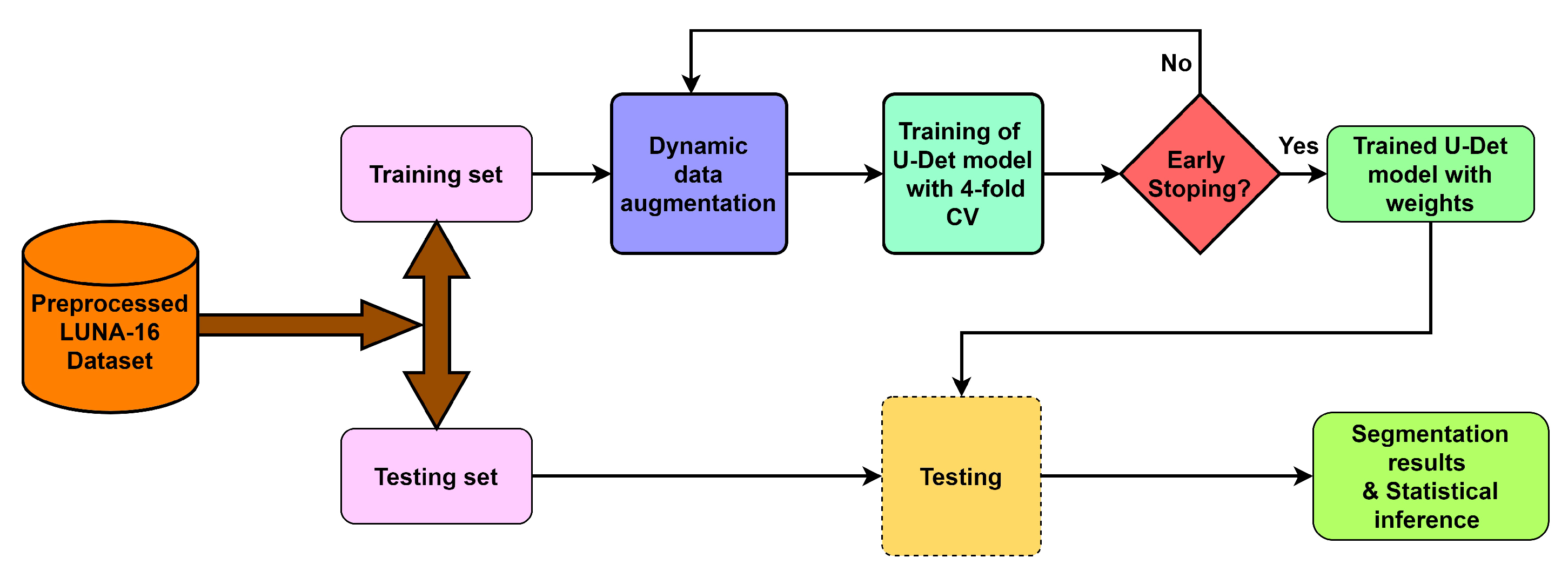
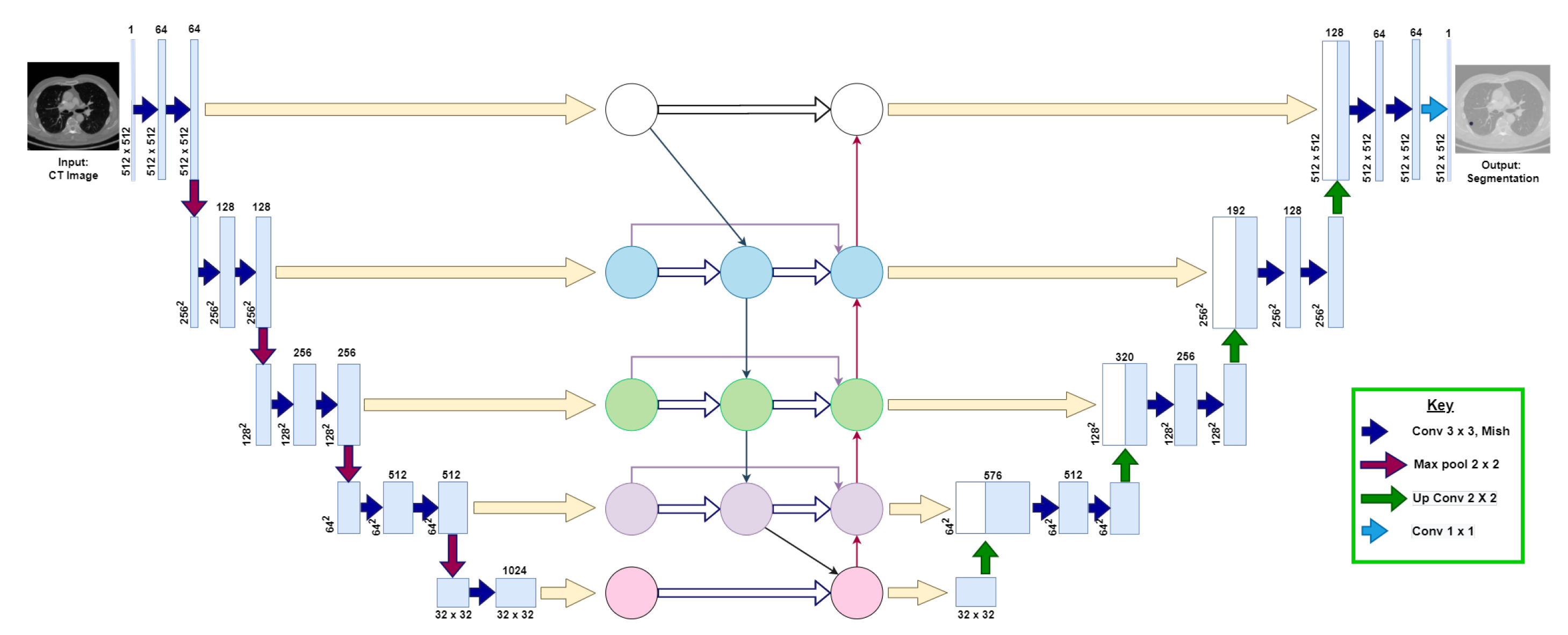
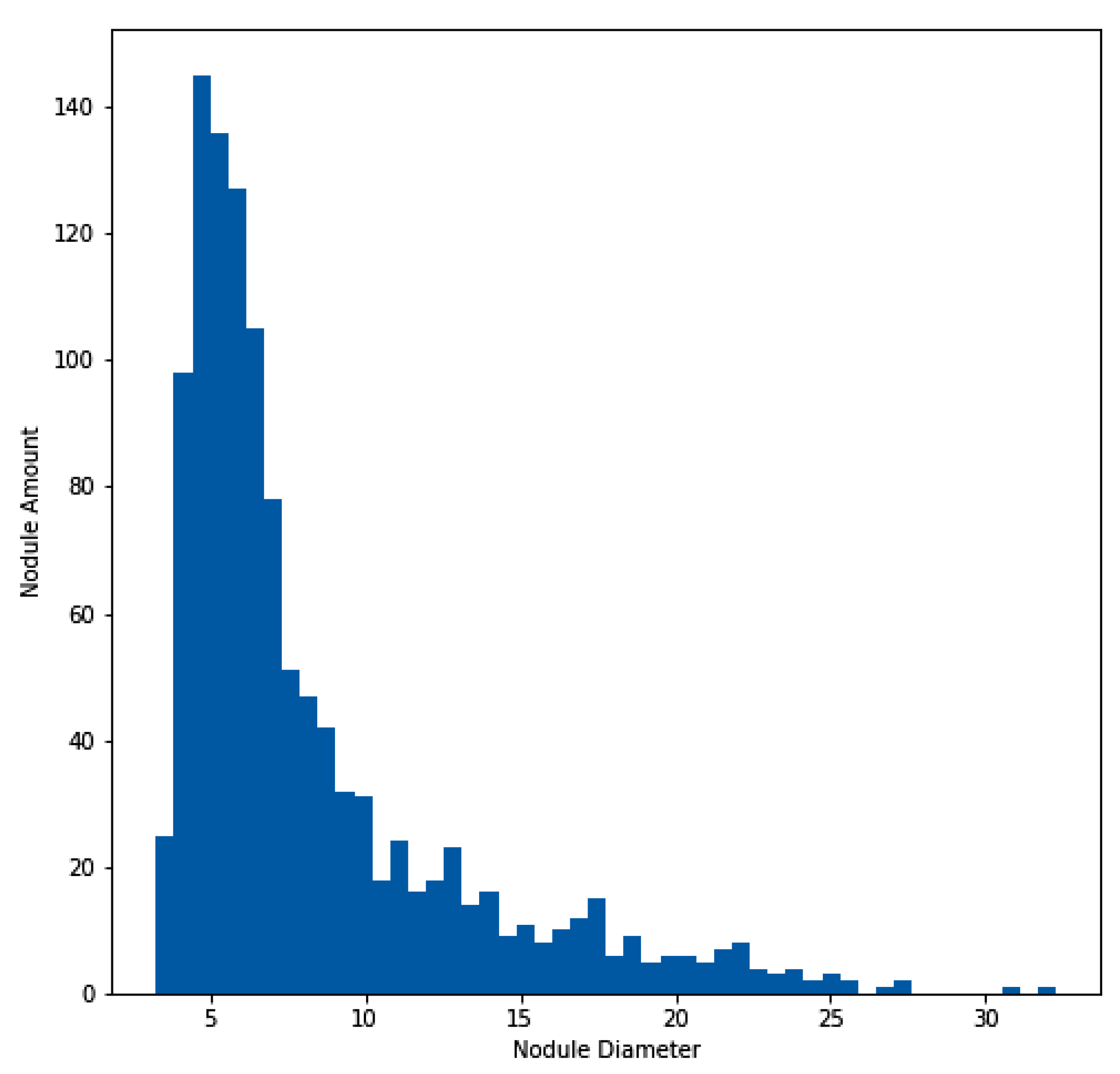
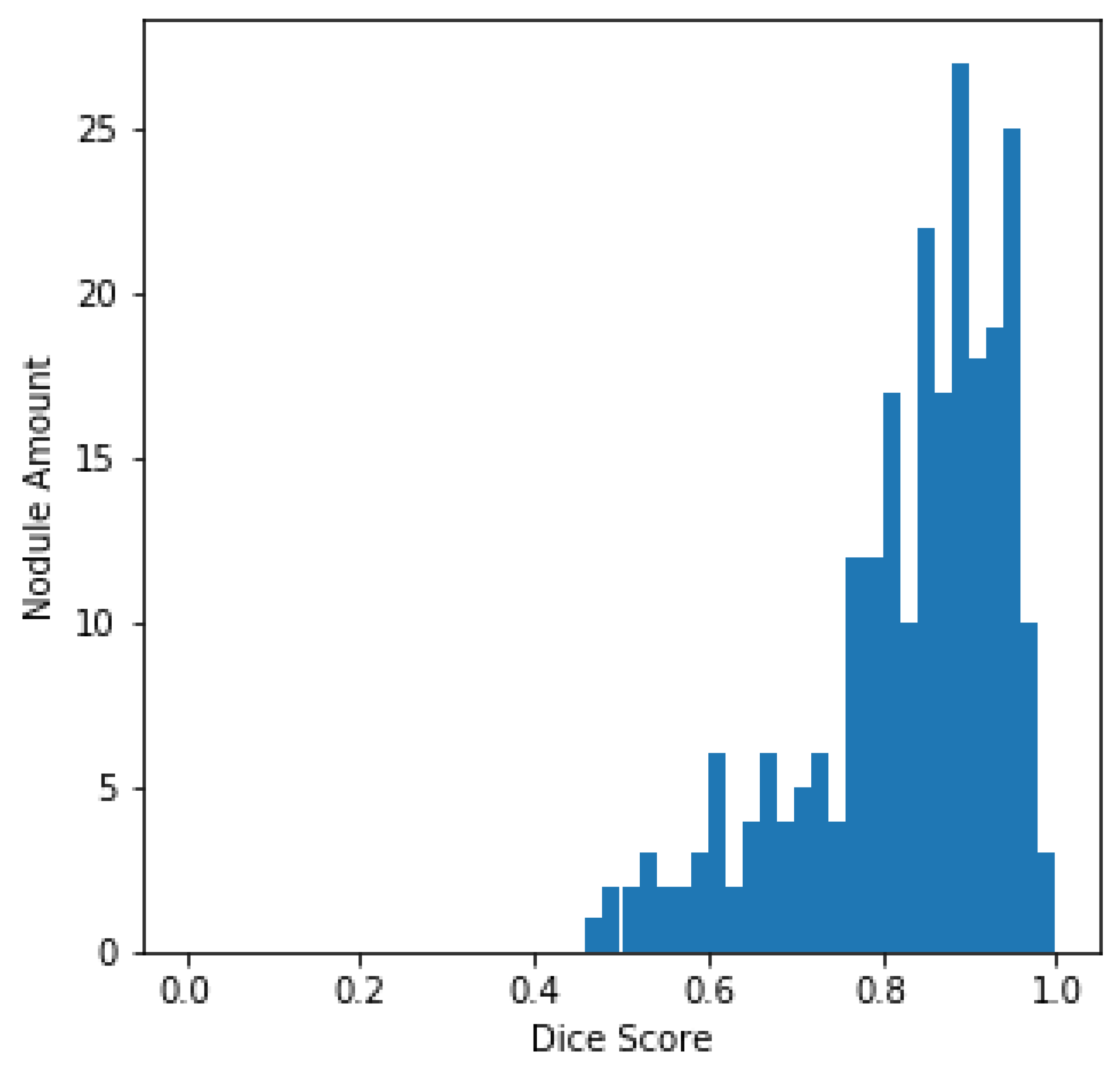
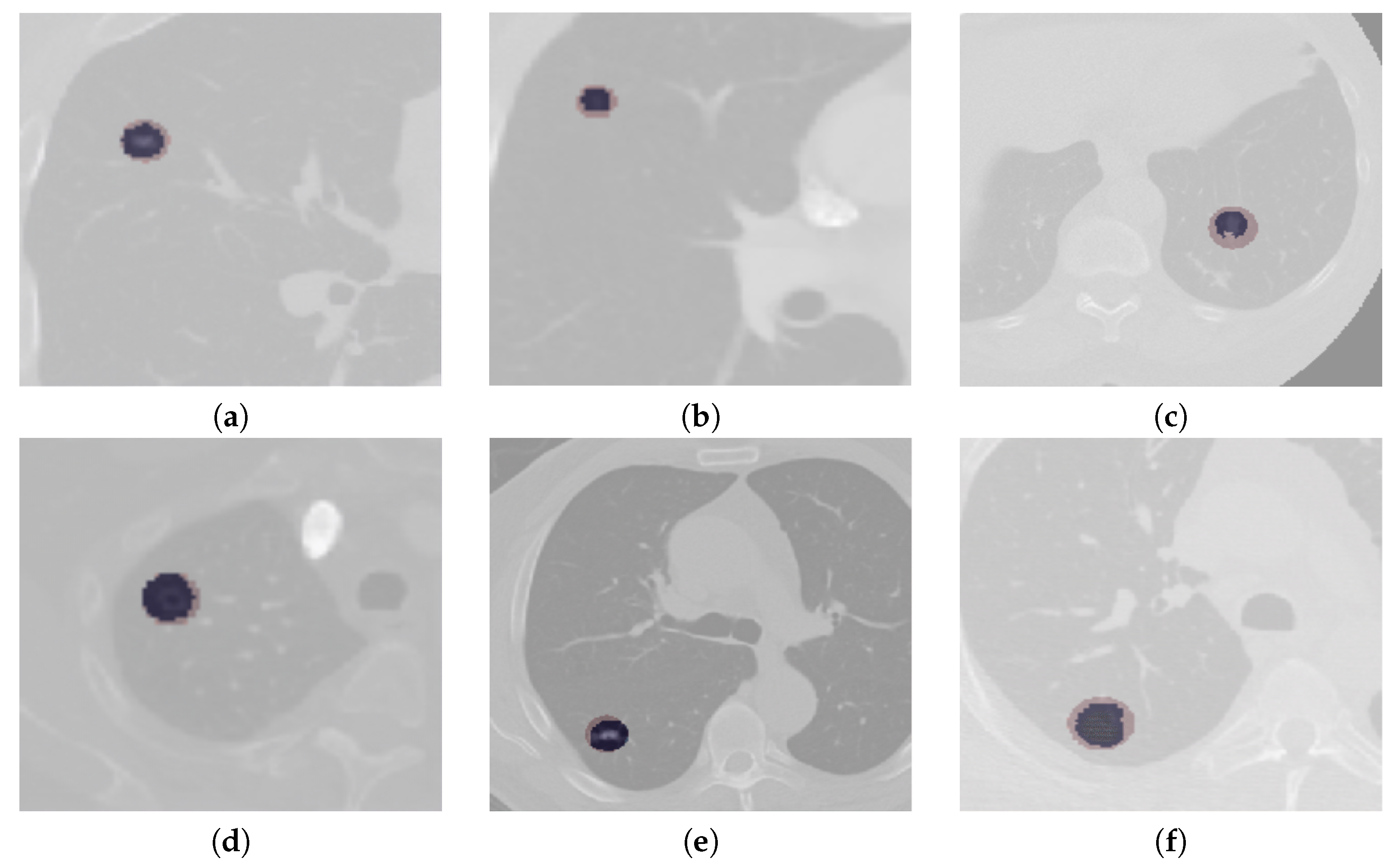
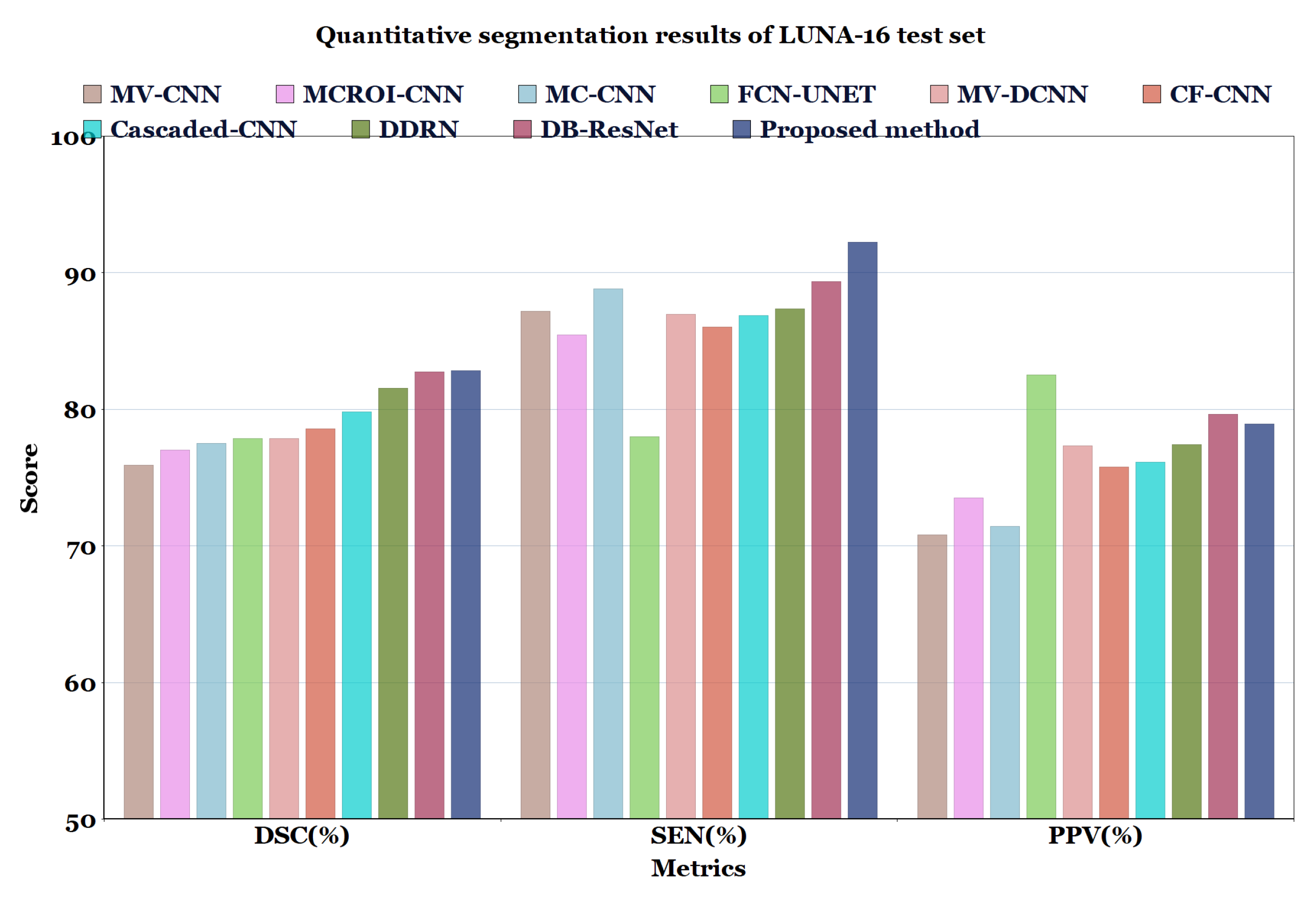
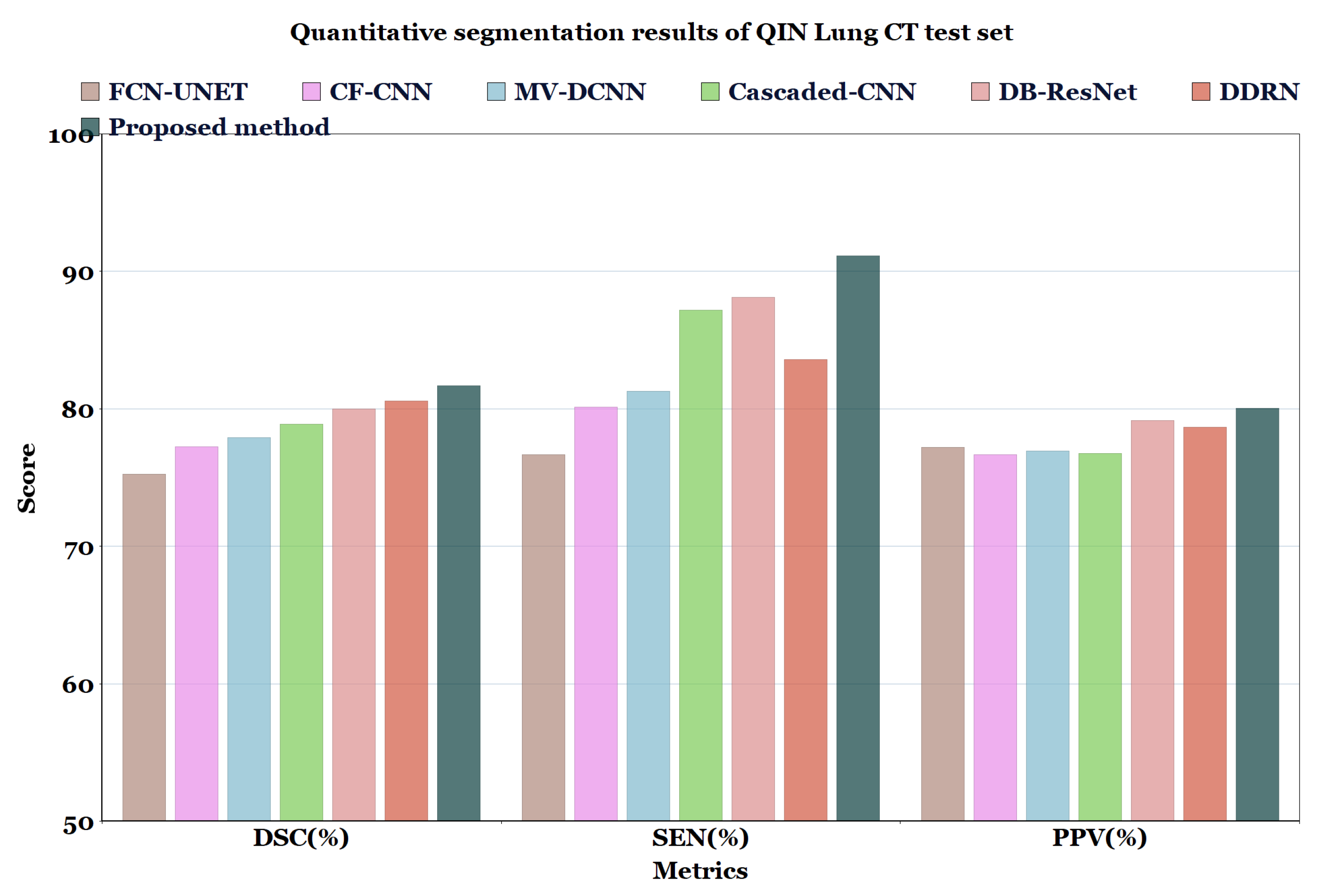

| Layer Name | Number of Parameters |
|---|---|
| Contraction path: | |
| Conv2D × 10, Mish | 1.884 |
| MaxPool2D × 4 | - |
| Bi-FPN: | |
| Conv2D × 5 | 1.269 |
| BatchNormalization × 12 | 3072 |
| ReLU × 12, MaxPool2D × 3 | - |
| DepthwiseConv × 7 | 4032 |
| Expansion path: | |
| Conv2D × 9, Mish | 6.821 |
| Conv2DTrans × 4, Mish | 2.786 |
| Total parameters: | 2.858 |
| Characteristics | Train Set (n = 922) | Test Set (n = 244) |
|---|---|---|
| Diameter (mm) | 8.13 ± 4.60 | 9.07 ± 5.24 |
| Margin | 4.03 ± 0.82 | 4.06 ± 0.76 |
| Spiculation | 1.60 ± 0.79 | 1.65 ± 0.87 |
| Lobulation | 1.73 ± 0.73 | 1.82 ± 0.80 |
| Subtlety | 3.91 ± 0.82 | 4.06 ± 0.78 |
| Malignancy | 2.95 ± 0.92 | 3.03 ± 1.00 |
| Method | DSC (%) | SEN (%) | PPV (%) |
|---|---|---|---|
| U-Net | 77.84 ± 21.74 | 77.98 ± 24.52 | 82.52 ± 21.53 |
| U-Net + Mish | 78.82 ± 22.01 | 78.97 ± 24.83 | 83.56 ± 21.80 |
| Encoder + Bi-FPN | 79.21 ± 12.49 | 84.40 ± 13.51 | 76.30 ± 14.42 |
| Encoder + Bi-FPN + Mish | 80.22 ± 12.33 | 85.47 ± 13.48 | 78.58 ± 14.34 |
| Encoder–Decoder + Bi-FPN + ReLU | 81.63 ± 11.85 | 91.06 ± 13.96 | 77.94 ± 13.68 |
| Proposed Method | 82.82 ± 11.71 | 92.24 ± 14.14 | 78.92 ± 17.52 |
| (a) LUNA16 Test set | ||||
| Attached (n = 56) | Non-Attached (n = 188) | Diameter < 6 mm (n = 104) | Diameter ≥ 6 mm (n = 140) | |
| DSC (%) | 81.82 | 83.11 | 83.40 | 82.40 |
| (b) QIN Lung CT Segmentation dataset | ||||
| Attached (n = 34) | Non-Attached (n = 122) | Diameter < 6 mm (n = 54) | Diameter ≥ 6 mm (n = 102) | |
| DSC (%) | 80.02 | 83.30 | 83.10 | 80.22 |
| LUNA16 Test Set | |||
|---|---|---|---|
| Network Architecture | DSC (%) | SEN (%) | PPV (%) |
| MV-CNN [51] | 75.89 ± 12.99 | 87.16 ± 12.91 | 70.81 ± 17.57 |
| MCROI-CNN [23] | 77.01 ± 12.93 | 85.43 ± 15.97 | 73.52 ± 14.62 |
| MC-CNN [16] | 77.51 ± 11.4 | 88.83 ± 12.34 | 71.42 ± 14.78 |
| FCN-UNET [5] | 77.84 ± 21.74 | 77.98 ± 24.52 | 82.52 ± 21.53 |
| MV-DCNN [18] | 77.85 ± 12.94 | 86.96 ± 15.73 | 77.33 ± 13.26 |
| CF-CNN [27] | 78.55 ± 12.49 | 86.01 ± 15.22 | 75.79 ± 14.73 |
| Cascaded-CNN [22] | 79.83 ± 10.91 | 86.86 ± 13.35 | 76.14 ± 13.46 |
| DDRN [30] | 81.56 ± 11.59 | 87.35 ± 12.39 | 77.42 ± 14.65 |
| DB-ResNet [28] | 82.74 ± 10.19 | 89.35 ± 11.79 | 79.64 ± 13.54 |
| Proposed Method | 82.82 ± 11.71 | 92.24 ± 14.14 | 78.92 ± 17.52 |
| QIN Lung CT Segmentation Dataset | |||
|---|---|---|---|
| Network Architecture | DSC (%) | SEN (%) | PPV (%) |
| FCN-UNET | 75.26 ± 11.82 | 76.65 ± 16.42 | 77.21 ± 11.57 |
| CF-CNN | 77.23 ± 11.53 | 80.12 ± 17.07 | 76.65 ± 12.20 |
| MV-DCNN | 77.89 ± 10.64 | 81.29 ± 15.60 | 76.95 ± 11.62 |
| Cascaded-CNN | 78.89 ± 11.89 | 87.20 ± 12.44 | 76.74 ± 13.52 |
| DB-ResNet | 80.01 ± 11.46 | 88.13 ± 12.34 | 79.13 ± 14.12 |
| DDRN | 80.56 ± 11.08 | 83.57 ± 11.78 | 78.65 ± 13.86 |
| Proposed Method | 81.66 ± 10.09 | 91.11 ± 12.01 | 80.05 ± 13.34 |
Disclaimer/Publisher’s Note: The statements, opinions and data contained in all publications are solely those of the individual author(s) and contributor(s) and not of MDPI and/or the editor(s). MDPI and/or the editor(s) disclaim responsibility for any injury to people or property resulting from any ideas, methods, instructions or products referred to in the content. |
© 2023 by the authors. Licensee MDPI, Basel, Switzerland. This article is an open access article distributed under the terms and conditions of the Creative Commons Attribution (CC BY) license (https://creativecommons.org/licenses/by/4.0/).
Share and Cite
Annavarapu, C.S.R.; Parisapogu, S.A.B.; Keetha, N.V.; Donta, P.K.; Rajita, G. A Bi-FPN-Based Encoder–Decoder Model for Lung Nodule Image Segmentation. Diagnostics 2023, 13, 1406. https://doi.org/10.3390/diagnostics13081406
Annavarapu CSR, Parisapogu SAB, Keetha NV, Donta PK, Rajita G. A Bi-FPN-Based Encoder–Decoder Model for Lung Nodule Image Segmentation. Diagnostics. 2023; 13(8):1406. https://doi.org/10.3390/diagnostics13081406
Chicago/Turabian StyleAnnavarapu, Chandra Sekhara Rao, Samson Anosh Babu Parisapogu, Nikhil Varma Keetha, Praveen Kumar Donta, and Gurindapalli Rajita. 2023. "A Bi-FPN-Based Encoder–Decoder Model for Lung Nodule Image Segmentation" Diagnostics 13, no. 8: 1406. https://doi.org/10.3390/diagnostics13081406
APA StyleAnnavarapu, C. S. R., Parisapogu, S. A. B., Keetha, N. V., Donta, P. K., & Rajita, G. (2023). A Bi-FPN-Based Encoder–Decoder Model for Lung Nodule Image Segmentation. Diagnostics, 13(8), 1406. https://doi.org/10.3390/diagnostics13081406







